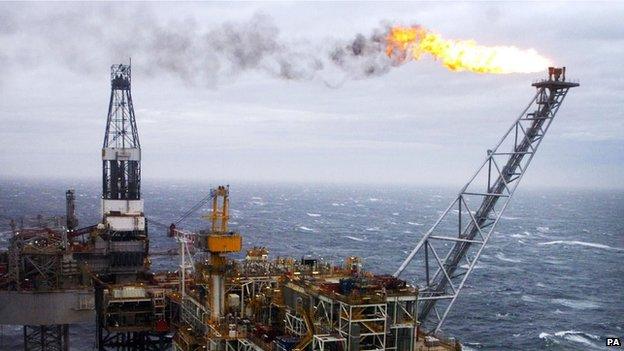Bright flare amid North Sea gloom
- Published

Not dead yet: the North Sea still has the capacity to spring a pleasant surprise for the oil and gas industry.
And the news from Statoil this week is that there's still the confidence to invest, even with the price of Brent crude being close to half its recent value.
The pessimism has been taken up by Bank of America Merrill Lynch this week, with talk of "devastating consequences" for North Sea investment from oil around $50, and dipping as low as $30.
Citibank this week added to the gloom, with a warning that oil prices could head close to $20.
Its analysts pointed to plentiful supply, as US shale continues in abundance, with Russia and Brazil continuing to try to pump themselves out of their troubles.
The market sentiment was on the side of more positive news, notably a 30% fall since November in the number of active oil fracking rigs in the US.
Assuming that means fracked wells will dry up in a few months, and won't be quickly replaced, that helped push Brent crude above $60 per barrel by week's end - the highest level this year.
Billions of barrels
With all the volatility, it's understandable that oil companies are holding back on investment decisions.
But one exception is Statoil in Oslo, which committed on Friday to a huge new investment. And when you look at the scale of what's proposed, you can see why they're looking beyond the current headlines to a field that should still be operational after 2050.
This is Johan Sverdrup, named after the first prime minister of Norway, and discovered from wells drilled in 2010 and 2011. It's only 155km west of Stavanger, 200 square kilometres, in 110m of water and 1,900m beneath the seabed.
The field contains somewhere between 1.8 billion and 2.9 billion barrels of oil, or its gas equivalent, of which Statoil with its partners, Lundin, Det Norske and Danish-based Maersk, expect to retrieve 70%.
With production planned from 2019, it should rise from 350,000 barrels per day to a maximum of about 600,000.
Statoil reckons it should require 51,000 person-years of work to get it into production, and 2,700 further person-years to run it.
Crowning achievement
And the money numbers are astonishing. First phase investment looks like £9bn. Revenues are forecast to come in at £115bn over 50 years. Of that, the Norwegian government is expected to take more than £57bn in tax.
Wood Mackenzie, the Edinburgh-based oil data and analyst consultancy, describes Johan Sverdrup as the "crowning achievement of Statoil's successful rejuvenation of exploration in more mature areas".
Analyst Malcolm Dickson said: "The world class Johan Sverdrup oil field has proven immune to the cuts in capital spending, standing out in a barren year for project sanctions."
So is this a sign that the gloom about the North Sea industry can be put aside - that this is evidence of the second wind blowing up a gale?
Not according to WoodMac. "Johan Sverdrup is unique in the global oil industry," said Dickson. "Oil fields of this size are not found in benign regions in shallow water any more."
So as production from the rest of the North Sea declines, by 2025, it is estimated that this one field will produce quarter of Norway's output, and will represent more than all of the output currently forecast from UK waters.
Not for the first time, Norway is proving to be not only better than Britain at handling the bonanza of North Sea oil, but luckier too.